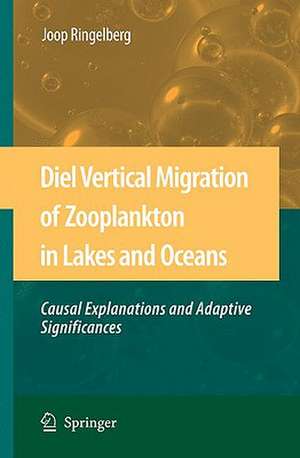Diel Vertical Migration of Zooplankton in Lakes and Oceans: causal explanations and adaptive significances
Autor Joop Ringelbergen Limba Engleză Hardback – 26 noi 2009
| Toate formatele și edițiile | Preț | Express |
|---|---|---|
| Paperback (1) | 948.16 lei 6-8 săpt. | |
| SPRINGER NETHERLANDS – 20 noi 2014 | 948.16 lei 6-8 săpt. | |
| Hardback (1) | 967.08 lei 6-8 săpt. | |
| SPRINGER NETHERLANDS – 26 noi 2009 | 967.08 lei 6-8 săpt. |
Preț: 967.08 lei
Preț vechi: 1179.37 lei
-18% Nou
Puncte Express: 1451
Preț estimativ în valută:
185.08€ • 192.51$ • 152.79£
185.08€ • 192.51$ • 152.79£
Carte tipărită la comandă
Livrare economică 15-29 aprilie
Preluare comenzi: 021 569.72.76
Specificații
ISBN-13: 9789048130924
ISBN-10: 9048130921
Pagini: 372
Ilustrații: XIII, 356 p.
Dimensiuni: 155 x 235 x 28 mm
Greutate: 1.07 kg
Ediția:2010
Editura: SPRINGER NETHERLANDS
Colecția Springer
Locul publicării:Dordrecht, Netherlands
ISBN-10: 9048130921
Pagini: 372
Ilustrații: XIII, 356 p.
Dimensiuni: 155 x 235 x 28 mm
Greutate: 1.07 kg
Ediția:2010
Editura: SPRINGER NETHERLANDS
Colecția Springer
Locul publicării:Dordrecht, Netherlands
Public țintă
ResearchCuprins
Windows: An Introduction.- Swimming in a Strange Biotope.- Light-Induced, Reactive Swimming.- A Decision-Making Mechanism.- Mechanistic Models.- Light and Temperature.- Optical Orientations.- Considerations Before Going into the Field.- Diel Vertical Migration in Lakes.- Migrations in the Marine Environment.- The Confrontation of Experimental and Field Studies.- From the Individual to the Population and Beyond.- Recapitulations and Considerations.
Textul de pe ultima copertă
The book deals with Diel Vertical Migration (DVM) of zooplankton in oceans and lakes and is the first critical discussion of the literature in 100 years of research. The accent is on photo-response experiments that revealed the physiological fundament unifying migration behaviour in both biotopes. Accelerations in relative changes in light intensity of dawn and dusk are the stimuli that trigger a PhotoBehaviour Mechanisms (PBM) evolved to realise predator evasion and starvation prevention. Physiology and behaviour are tuned to these adaptive goals. A "set of ecological factors" is necessary and an algorithm shows the operation of the "set". However, not only the kinetic component of behaviour is based on light, also orientation but now the angular light distribution is responsible. Contrast orientation as in Daphnia may also hold for other animals, for example, Euphausia.The application of the PBM in lakes and oceans is demonstrated amongst other for the vertical movements of Sound Scattering Layers. These layers move faster, slower or as fast as an isolume which was a problem for the decennia long explanation that migrating animals followed an optimal light intensity. The enigma was solved. Using time series of changes in population size, egg ratios, development times and death rates due to predation by juvenile fish, the influence of DVM on population dynamics was analysed. Finally, covering the flow of matter in the traditional food web by a network of information transitions illustrates the controlling function of infochemicals, such as fish kairomones.
Caracteristici
The first book on Diel Vertical Migration after 100 years of research A critical discussion of an important aspect of zooplankton life in the marine and freshwater environment Discusses the cause of a unified migration behaviour Discusses of the effect of migration on population dynamics





